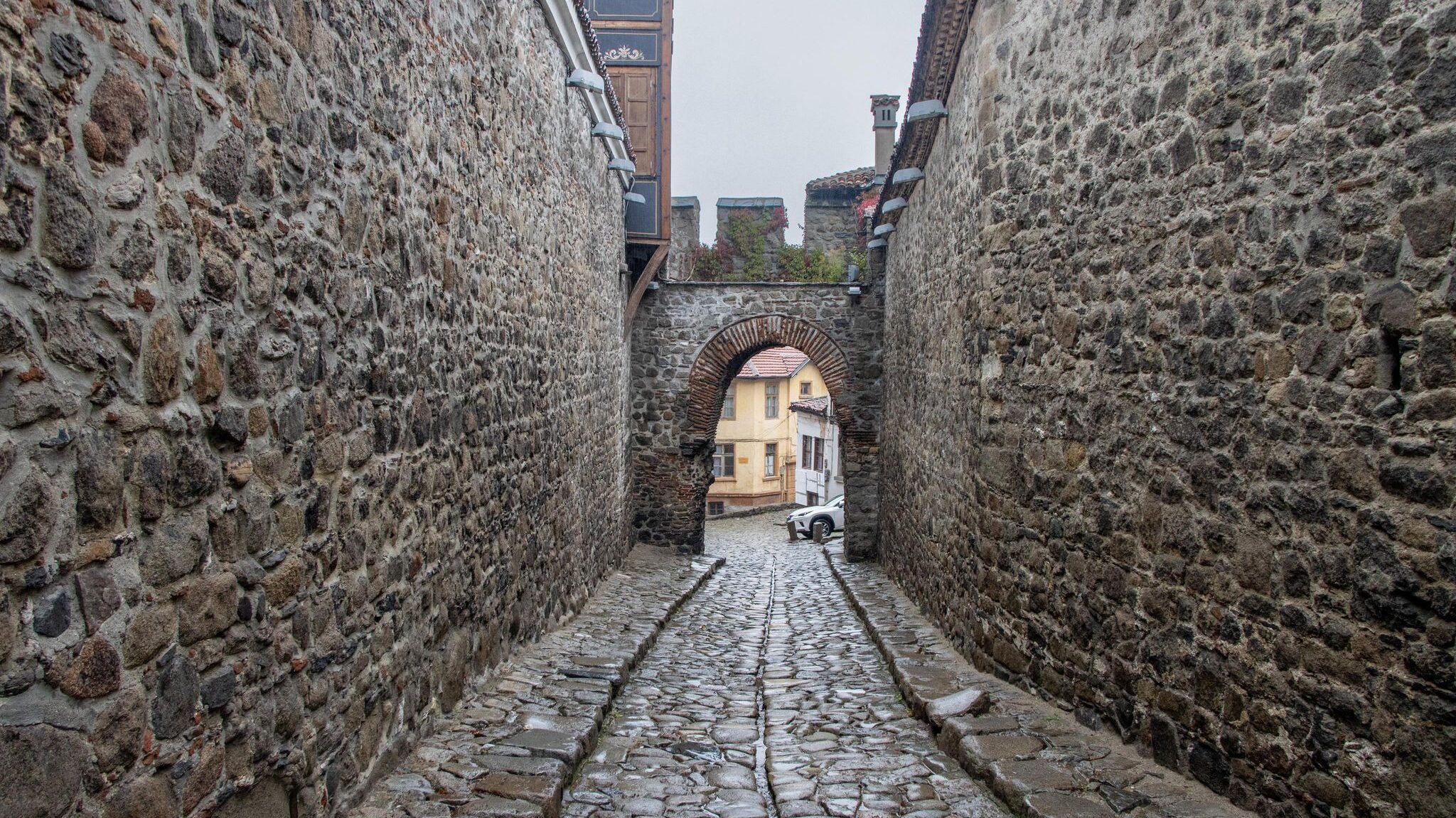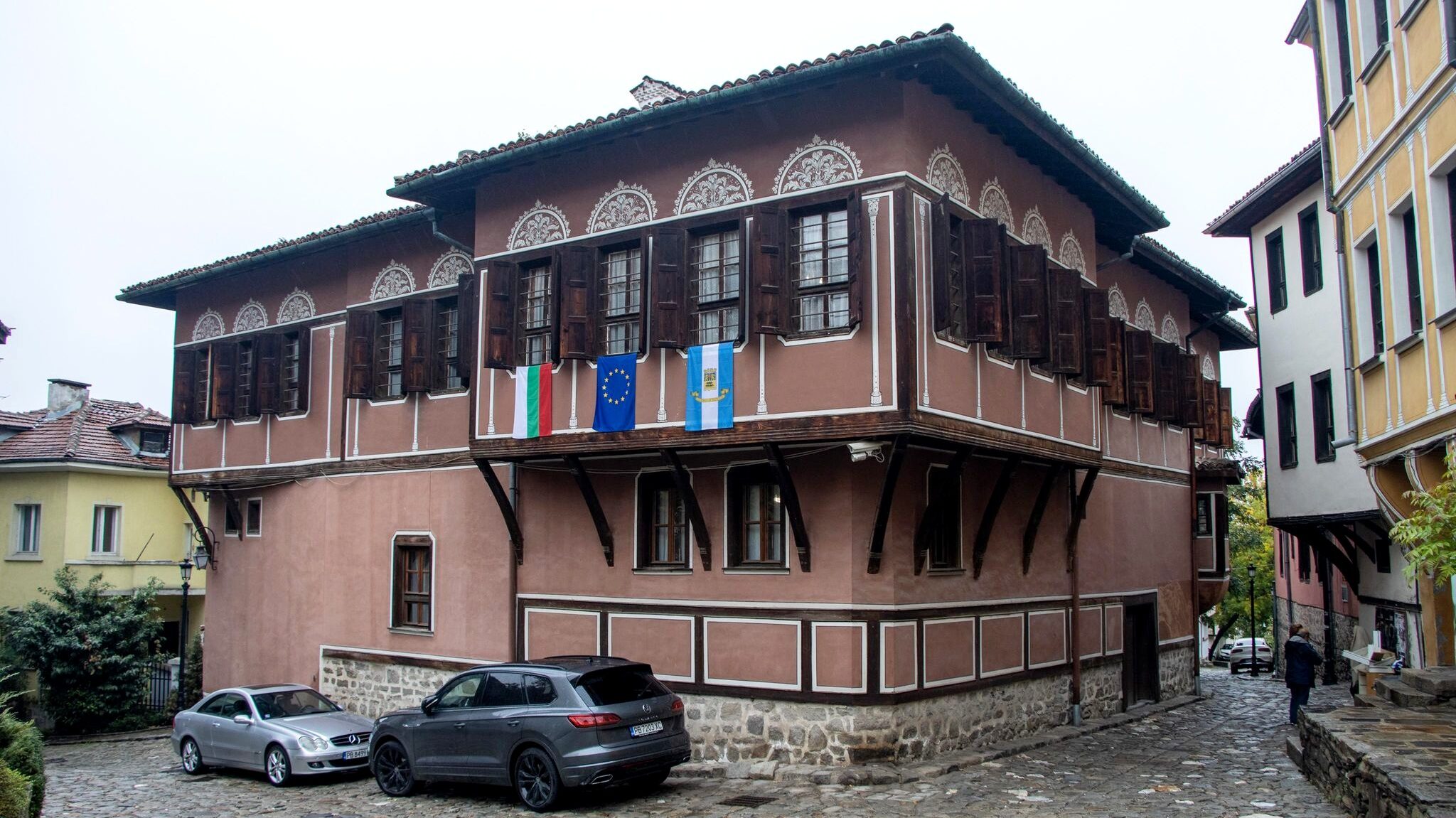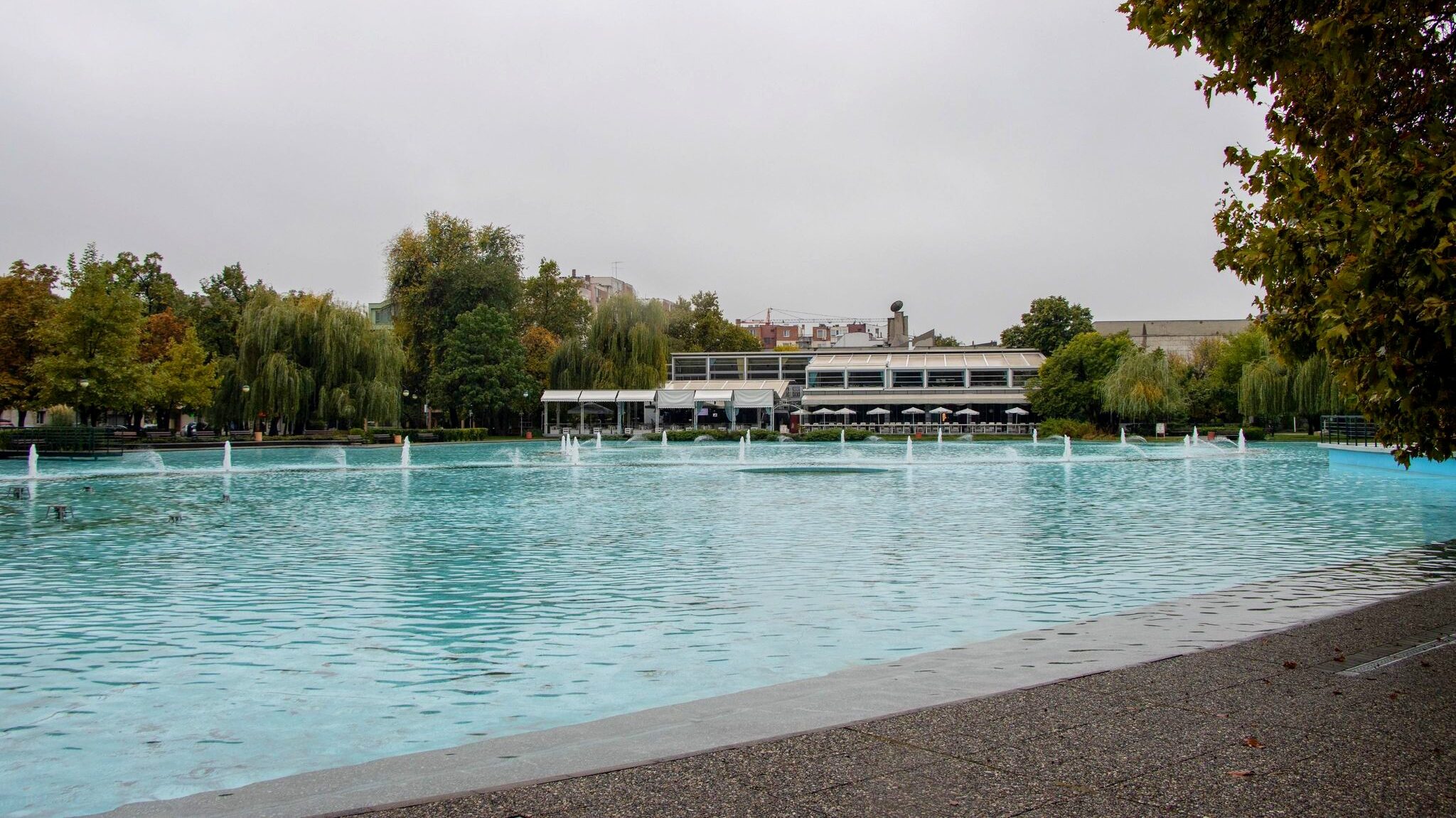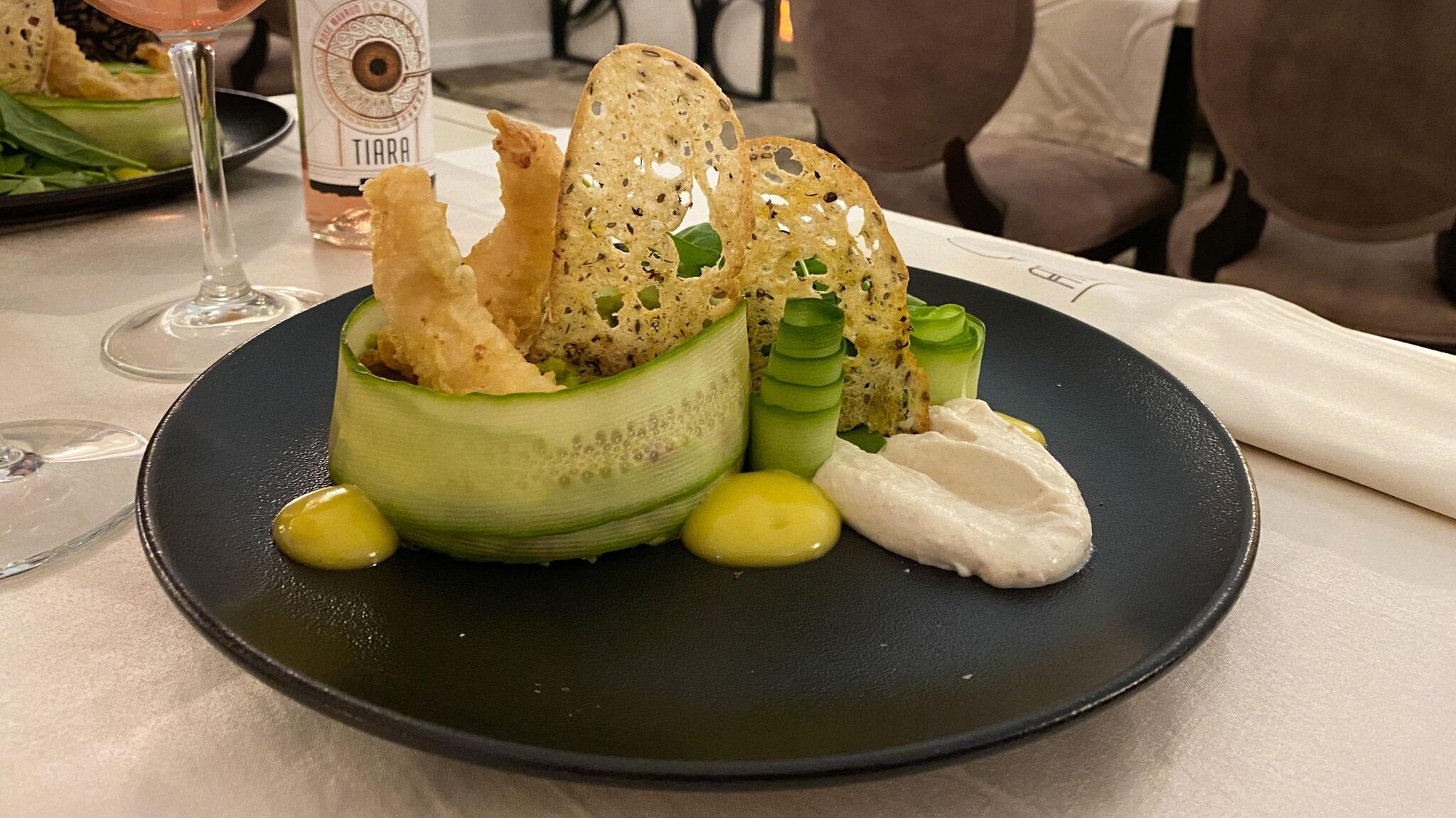Plovdiv is one of the most popular cities in Bulgaria, and after visiting it’s not hard to see why. Dating back to the 6th century BC, Plovdiv is considered to be one of the oldest cities in the world. There are traces of ancient civilizations popping up at almost every turn. I can promise you that there’s no shortage of things to do in Plovdiv.
Plovdiv is known as the City of Seven Hills, so make sure you bring good walking shoes. If medieval history is your thing, Plovdiv’s old town is essentially a living museum. You can enjoy walking along the cobblestone streets and learning more about its development from ancient times.
We made a stop in Plovdiv after visiting the area surrounding the Central Balkan National Park, and although we had terrible weather we still managed to make the most of it. Many people choose to spend one day in Plovdiv. But in all honesty there are so many unique attractions in Plovdiv to visit that I would recommend spending at least 2 days here. Aside from the tourist attractions, Plovdiv has a pretty great food scene too. Here are my top tips for the best things to do in Plovdiv.
Places to park in Plovdiv
There are a lot of parking lots at the base of the old town. I would recommend parking here as it’s not too pricey considering its central location, and its monitored by a guard. You aren’t allowed to drive through the old town so be prepared to walk uphill wherever you end up parking in Plovdiv.
Things to do in Plovdiv
Roman Theatre of Philippopolis

The main attraction in Plovdiv is the Roman Theatre of Philippopolis. It’s one of the world’s best preserved ancient Roman theatres, and considering its popularity with tourists, it’s very inexpensive to enter, costing the equivalent of €2.50.
The theatre dates back to the 1st century AD, but in the 5th century it was severely damaged by Attila the Hun. The theatre wasn’t uncovered until the 1960’s, when a landslide caused part of the ruins to appear, prompting a large archaeological excavation. During the restoration process, as much of the original elements as possible were used, and today it stands proudly as one of the best things to see in Plovdiv.
The entry ticket gives you access to the stands and you can also wander down to the stage area for a different perspective of the theatre. If you’re lucky enough to be visiting Plovdiv when there’s a live performance on, I’d highly recommend purchasing a ticket for it.
Plovdiv’s old town

Plovdiv’s old town really is a beautiful part of the city to walk around, even on a rainy day. Many of the top things to do in Plovdiv are located within the old town and are easily accessible by foot if you don’t mind a few hills and walking on cobblestones. The old town stretches across 3 hills and is a stunning blend of different periods of history.
The Roman Theatre of Philippopolis was the first attraction we came across as we entered the old town, and from there we discovered many buildings and historical sites dating from the Middle Ages to the Bulgarian Revival period. Walking around the old town is one of my favourite things to do in Plovdiv and is a must for any first time visitor.
Lamartine House

Lamartine House is currently closed to visitors due to planned restoration work, but it’s worth taking a quick look at from the outside. It was built in 1830 and in 1833 played host to the French poet, Alphonse de Lamartine. It’s also one of the largest and most innovative houses in the old town. Lamartine House is only a few minutes walk from the Roman theatre, and is along the route to many of the other museums in Plovdiv’s old town, so you can’t miss it.
Mevlevi Hane

Mevlevi Hane is one attraction in Plovdiv you’ll probably walk past if you’re not actively looking for it. It’s quite an unimposing building compared to others in the old town. This Dervish Monastery was once the home of Muslim monks until the end of the 20th century, and is said to be the only one of its kind.
Today it functions as a restaurant but you can still catch a glimpse of the famous Dancing Dervish in the form of a painting on the entry wall. Much of the building’s original Persian architecture is still very much on display. It’s one of the most unique things to see in Plovdiv, so make sure you pop your head in.
Church of St Constantine and Helena

The Church of St Constantine and Helena is one of the most impressive things to see in Plovdiv. It was built in 337 AD on the site of an ancient pagan temple, and was named after Constantine the Great and his mother. This makes it one of the oldest Christian churches in Plovdiv.
Over the centuries it’s been destroyed and rebuilt many times, so the building you see today only dates back to the 19th century. The architecture and impressive frescoes on the walls mark a significant time in Plovdiv’s history and are incredible to look at. The church is completely free to enter but there’s a small fee if you want to take photos inside.
Regional Ethnographic Museum

One of the main museums in Plovdiv is the Regional Ethnographic Museum. It’s the second largest museum of its kind in Bulgaria and features six exhibitions spread across separate rooms. The building that the museum now sits in is known as Kuyumdzhioglu House, and was built in 1847 for a prominent merchant.
If this kind of museum doesn’t sound very interesting to you, I would highly recommend visiting the gardens outside of it and taking some photos of the building. It’s one of the most Instagrammable places in Plovdiv. Plus, this is one of the best free things to do in Plovdiv.
Hisar Kapia

Sitting next to the Regional Ethnographic Museum is this stunning 11th century medieval gate known as Hisar Kapia. It’s one of the main tourist attractions in Plovdiv and sits among other key points of interest in the old town. It was most likely built on top of an ancient Roman gate which would have been one of 3 entrances to the acropolis of Philippopolis (the name of ancient Plovdiv).
As you walk towards the gate, you’ll notice that there are 17th and 18th century merchant houses built onto the main wall, which is a shame but makes for a colourful photo opportunity!
Street of Crafts

The Street of Crafts, or Stramna Street, is a bit of a hidden gem in Plovdiv that many tourists don’t realize is tucked away down a narrow street. After passing through Hisar Kapia there are signs pointing to this unique street, which is a struggle getting to on the wet cobblestones.
The street is made up of several houses where artisans can practice and display their traditional Bulgarian crafts. You can get a lot of unique and handmade souvenirs here too. If you’re interested in visiting these shops, I would recommend going early, especially in the off-season, as they have varying closing times.
Nebet Tepe

As I mentioned earlier, Plovdiv is a city built over 7 hills, though one of these hills was eventually destroyed. The most well-known of these hills is Nebet Tepe, which is a popular place in Plovdiv to watch the sunset from. As you can see from this photo, it was incredibly foggy when we were in Plovdiv, so we didn’t get the views we wanted. However, we were still able to explore the fascinating archaeological complex at Nebet Tepe.
The oldest settlement on this hill dates back to the 6th century BC, and as the settlement expanded through the Thracians and Romans, Nebet Tepe became the citadel of the city. Today you can see some of the ruins of the city walls and buildings dating back to approximately the 4th century BC. Since it’s one of the best free things to do in Plovdiv you shouldn’t pass on the opportunity to visit Nebet Tepe.
Balabanov House

There are many unique and interesting museums in Plovdiv’s old town, but one of the most popular is Balabanov House. It’s one of the most beautiful Bulgarian mansions from the National Revival era in the city, and is a key point of interest in Plovdiv.
This house was built on the orders of a wealthy merchant at the beginning of the 19th century, but by 1935 it was demolished due to years of neglect. The building you see today is a reconstruction from the 1970’s, but the architect followed the original building plans to make it as authentic as possible.
Municipal Institute “Ancient Plovdiv”

Sitting next to Balabanov House is the Municipal Institute “Ancient Plovdiv”. This museum was established in 2004, and is actively involved in the restoration and conservation of the old town. It was also another building that was closed when we visited Plovdiv, so I’m not entirely certain if you can go inside it and see any exhibitions. It’s still a beautiful traditional building to take a photo of though.
Hindliyan’s House

In my opinion, the most picturesque museum-house in Plovdiv’s old town is Hindliyan’s House. To find it, you need to pass through the gardens of another museum-house and then walk through a hallway until you come out on the other side. There are no signs for it either so it’s quite fun to find.
Hindliyan’s House was completed in 1835 and is one of only a few houses in Plovdiv that has kept its original symmetrical design. It’s named after its first owner, a wealthy merchant who frequently travelled to India. Entry on the first Thursday of the month is free for students and people who are retired, so keep that in mind if it applies to you.
Tsar Simeon Garden

Plovdiv’s old town is clearly one of the main reasons to visit the city, but there are many interesting tourist attractions scattered around modern Plovdiv too. One of the most beautiful open spaces in Plovdiv is the Tsar Simeon Garden which was created in 1892 by a Swiss landscape architect. Other than strolling through the park, you can enjoy a light and sound show at the Singing Fountains on certain evenings. It’s one of the best things to do in Plovdiv at night.
Roman Forum and Odeon

Remains of ancient civilizations that once called Plovdiv home can be found everywhere in the city, not just in the old town. Located among modern buildings, the Roman Forum and Odeon is one of the most popular things to do in Plovdiv, and as a bonus it’s completely free.
This part of the city would have been where meetings, government affairs, and festivals were held as well as many other important events. Archaeologists also uncovered the remains of a library here, which is something very few cities in ancient times had.
Stefan Stambolov Square

Not far from the Roman Forum and Odeon is Stefan Stambolov Square, located within the main pedestrian area of the city. At one end of the square is where you’ll find the Municipality Building, and in the centre sits a pretty water fountain that’s surrounded on the other side by cafes and restaurants.
During the warmer months, you might be able to catch one of the many festivals that take place here. It’s not a major tourist attraction in Plovdiv, but it is nice to walk around, especially if you’re looking for somewhere to eat.
Glavnata

If you want to do some shopping in Plovdiv, Glavnata should be your first calling point. Glavnata is the main street in Plovdiv, running from the modern city right through the heart of the old town. Stretching 2km, Glavnata is one of the longest pedestrian streets in the world and is a bustling centre both during the day and in the evening.
I would recommend visiting H&M while you’re here, not for the clothes but for the ancient Roman ruins that sit under the floor. You can pay a small entry fee to go into the basement to look at them, but you get a good view from the escalators as well. It’s one of the most unusual things to do in Plovdiv.
Milyo Statue

As you walk down Glavnata, don’t forget to stop and take a photo with the town gossip and prankster – Milyo. This isn’t your typical point of interest in Plovdiv, but the Milyo Statue is a prominent feature along the main shopping street, depicting a local man who was very well known around the city.
Next to the statue is the “together” sign which was the slogan when Plovdiv was named the 2019 European Capital of Culture – the first Bulgarian city to be chosen. Both the statue and sign are unique spots for photos in Plovdiv.
Ancient Stadium of Philippopolis

The Ancient Stadium of Philippopolis sits in the very centre of modern Plovdiv, and dates back to the 2nd century AD. When it was built, Philippopolis was the capital of the Roman province of Thracia and today it stands as one of the best preserved Roman remains in the Balkans.
My photo unfortunately doesn’t show the impressive stadium in its entirety because I was attempting to shelter from the rain. For a small entry fee you can gain access to the stadium and explore the city of Plovdiv at its original level. It’s one of the top things to do in Plovdiv so make sure you add it to your itinerary.
Dzhumaya Mosque

Shadowing over the Roman stadium is the beautiful Dzhumaya Mosque, the main Muslim shrine in Plovdiv. It was built in the 14th century after the conquest of the city by the Ottoman army, though it was later demolished and rebuilt in the 15th century.
It’s considered to be one of the oldest and largest cult Ottoman buildings in the Balkans. Its unique features includes 9 domes, which is a stark contrast to mosques from later periods. Even in the rain, the mosque is very impressive and visiting it is definitely one of the best things to do in Plovdiv.
Kapana

If you enjoy visiting quirky neighbourhoods, you’re going to love Kapana. This creative district in Plovdiv has been the most inhabited part of the city since the Middle Ages, and is very well known for its vibrant colours and unique shops and restaurants. Once a centre of trade and services, Kapana is now a vibrant area of the city that continues to grow in popularity among locals and tourists.
The name Kapana translates to the trap due to its narrow medieval streets, which we found to be quite accurate as it’s difficult to navigate out of once you’re inside them. We even stumbled across a Central Perk on one of the streets for all of you Friends fans out there. Make sure you add Kapana to your list of things to do in Plovdiv because there’s no other district in the city quite like it.
Where to eat in Plovdiv
Bluestone Doughnuts

Doughnuts for breakfast usually aren’t my thing, but Bluestone Doughnuts came highly recommended in a number of Plovdiv travel blogs so we had to stop by. The reason we chose to visit for breakfast was because they sell out of their freshly made doughnuts within a few hours of opening.
“The first handmade doughnuts in Bulgaria” are some of the best I’ve ever had, and you can expect new flavours on the menu regularly. Naturally, I went for a Boston Cream doughnut. The cafe emits a very cozy atmosphere inside, which was perfect when we visited since it was a cold and rainy day. If you don’t have time to sit in, you can take your doughnuts to go with you. Grabbing a doughnut at Bluestone Doughnuts is easily one of the best things to do in Plovdiv if you have a sweet tooth.
Skapto

Located in the very centre of Kapana is Skapto. This burger restaurant offers a great selection of mouthwatering burgers (vegetarian options available too), as well as a unique blend of fries. If you don’t think the burger and fries are enough, you can always ask for your burger to be drenched in a cheesy sauce.
The burgers aren’t served with fries, so make sure you order a plate to share because the portion is quite large. Some of the burgers at Skapto are enormous, so you may not even need to add the fries to your order. Overall, it’s a great place to eat in Plovdiv and relax after working through your list of things to do in Plovdiv.
Brick House

Also located in Kapana is the Brick House. I tried to stay on the healthier side by ordering a salad, but as soon as I heard the dessert options I had to add their chocolate ganache cake slice to my order as well. Brick House is known for its meat dishes, so it may not be the best option for vegetarians or Vegans, but they do offer a few meatless choices on their menu.
I would recommend ordering a plate of their cheese balls for a starter if you’re feeling hungry – they were my favourite part of the meal. On a nice day, you can sit outside and enjoy the atmosphere of Kapana too while you look through your list of things to do in Plovdiv.
Rahat Tepe

Rahat Tepe is synonymous with the city and is considered to be one of the best restaurants in Plovdiv by both locals and tourists. It sits at the top of Nebet Tepe, at the entrance to the ancient ruins on the hill, and is known for its lively atmosphere and non-fussy, local Bulgarian food and drinks.
The outdoor beer garden offers incredible views over the modern city. If you’d rather be more cozy on a cold and wet day you can sit inside and enjoy the views from the window. Although we didn’t try any of the food here, a cup of hot chocolate and a sip of rakia (a must-try Bulgarian spirit) kept us warm enough to trudge through the rain.
Mykonos

You’ll probably need a car to get to Mykonos, or at least know how to navigate the public transportation system, but it’s worth the trip. This family-run restaurant has been serving authentic Greek food since 1996, and its interior is just as impressive as its entryway. We ordered a large selection from their menu so that we could sample a variety of different dishes.
They have everything from freshly prepared sushi to pasta dishes – and of course, Greek food too. Parking in Plovdiv can be tricky, but luckily the restaurant is across the road from a lot of free parking spaces so you should have no issues finding a spot. If you’re in the mood for something Greek (or sushi) while in Plovdiv, head over to Mykonos.
Atlas Restaurant

Just next to Stefan Stambolov Square, which is one of the top things to do in Plovdiv, is the very popular Atlas Restaurant. I would recommend visiting this restaurant if you’re in the mood for a fancy dining experience. There are 2 levels to the restaurant, which is situated inside a hotel, with the downstairs level being more modern and the upstairs having more of a fine dining vibe to it.
The food we were presented with was beautifully prepared and freshly made. I even added a cocktail to my meal which was a lot bigger than I expected. If you find yourself in this part of the city, Atlas Restaurant is a good choice for an evening meal.
Where to stay in Plovdiv
Holiday Inn Plovdiv

Wondering where to stay in Plovdiv? We chose to stay at the Holiday Inn Plovdiv, which was only a short drive from the city centre, and is more catered to business travellers. Our room featured a large double bed, plenty of wardrobe space, and a desk big enough to work on your laptop from.
Fresh towels were folded in the bathroom, which also came with a few toiletries as well. After a long day of walking through Plovdiv in the rain, this hotel room was perfect to come back to. Although it’s situated along one of the main streets, we had no sound issues and had a very relaxing sleep.

Holiday Inn Plovdiv is a very modern hotel with a beautiful lobby and restaurant area. There are plenty of seats dotted around the lobby, as well as a computer area which is available for use if you need to look something up or use a printer.
Parking is available on-site but you need to book ahead as there are limited spaces available. Overall, Holiday Inn Plovdiv is a great place to stay in Plovdiv if you want to be close to the city centre but also have easy access out of the city.
>> Click here for the most up to date prices at Holiday Inn Plovdiv <<
Plovdiv is one of the most beautiful cities in Bulgaria, and is definitely worth exploring for more than a day. If you’re planning on visiting Plovdiv as part of a day trip from Sofia though, it really is one of the best places to visit in Bulgaria so it will be worth your time. There are plenty more unique places in central Bulgaria to explore if you can fit them into your schedule. If you’re only in this region of the Balkans for a short period, there are a lot of great things to do in Plovdiv that you simply cant miss.
Have you been fortunate enough to explore Plovdiv before? We’re hoping to plan a return trip when the weather is better, so please let me know of any other recommendations that you have. You can also follow my travels on Instagram!
This post may contain affiliate links, which means I may earn a commission from the discount codes used or when a link/ad is clicked. All purchases made will come at no extra cost to you, and I only include products and services that I would personally recommend.
Pin this blog post for later!





